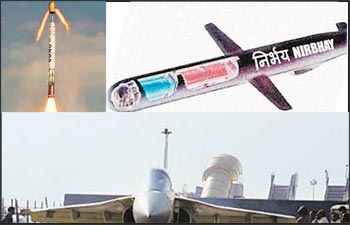- Joined
- Apr 5, 2009
- Messages
- 11,615
- Likes
- 5,772
The beginning of the New Year is crucial for some key defence projects which promise to boost the country's second-strike capability significantly.
Lined up in the coming weeks are the final trial of underwater missile K-15, meant for nuclear submarine Arihant , maiden test of subsonic cruise missile Nirbhay and first flight of Limited Series Production (LSP-8) of Light Combat Aircraft Tejas.
Sources said the final test of K-15 is expected to take place in January. Once the trials are over, the missile would be integrated with Arihant, the nuclear-powered submarine being developed at home.

Defence scientists said the missile has performed well and its underwater launch capability is shaping up well. The last trial of the missile was conducted from a pontoon in the Bay of Bengal in December last year.
Sources said one more test is required for the final acceptance of the system. Its development is crucial for the success of the Arihant programme, which is expected to go for sea trials soon. The harbour trials of the submarine have been completed.
Navy Chief Admiral D.K. Joshi had said last month that the nation can expect some good news in the Arihant development process. The K-15 missile will be followed by K-4, which will have a longer range of around 3000 km.
Another missile that is lined up for test is the sub-sonic cruise missile Nirbhay. Sources said the first trial of the missile is expected to be held this month.
The missile has a range of 750 km and can be launched from land, sea and air. Its launch has already been delayed by three months as it was expected to take place in October 2012. The defence scientists are also hoping to fly Tejas LSP-8 this month. The Light Combat Aircraft would finally be handed over to the Indian Air force for trials.
Sources said the LSP-8 is under production and preparations are in full swing for its first flight, which is already delayed by at least a year.
The IAF is expected to fly Tejas during the Iron Fist exercise in February. Iron Fist will be first day and night exercise in which live firing will be practiced.
This is the first time that Tejas will form a part of an extensive IAF drill in the Rajasthan desert. The IAF is looking to raise two squadrons of Tejas to begin with. It is hoping that the aircraft will get the second Initial Operational Clearance sometime this year, said sources.
Another crucial system, the Astra Beyond Visual Range Airto-Air missile, was successfully tested in December under simulated environment. The missile would soon be fired from IAF's Su-30 MKI combat jet.
Read more at: Set to boost India's second-strike capability, new defence projects set for a giant leap this year : North, News - India Today
Lined up in the coming weeks are the final trial of underwater missile K-15, meant for nuclear submarine Arihant , maiden test of subsonic cruise missile Nirbhay and first flight of Limited Series Production (LSP-8) of Light Combat Aircraft Tejas.
Sources said the final test of K-15 is expected to take place in January. Once the trials are over, the missile would be integrated with Arihant, the nuclear-powered submarine being developed at home.

Defence scientists said the missile has performed well and its underwater launch capability is shaping up well. The last trial of the missile was conducted from a pontoon in the Bay of Bengal in December last year.
Sources said one more test is required for the final acceptance of the system. Its development is crucial for the success of the Arihant programme, which is expected to go for sea trials soon. The harbour trials of the submarine have been completed.
Navy Chief Admiral D.K. Joshi had said last month that the nation can expect some good news in the Arihant development process. The K-15 missile will be followed by K-4, which will have a longer range of around 3000 km.
Another missile that is lined up for test is the sub-sonic cruise missile Nirbhay. Sources said the first trial of the missile is expected to be held this month.
The missile has a range of 750 km and can be launched from land, sea and air. Its launch has already been delayed by three months as it was expected to take place in October 2012. The defence scientists are also hoping to fly Tejas LSP-8 this month. The Light Combat Aircraft would finally be handed over to the Indian Air force for trials.
Sources said the LSP-8 is under production and preparations are in full swing for its first flight, which is already delayed by at least a year.
The IAF is expected to fly Tejas during the Iron Fist exercise in February. Iron Fist will be first day and night exercise in which live firing will be practiced.
This is the first time that Tejas will form a part of an extensive IAF drill in the Rajasthan desert. The IAF is looking to raise two squadrons of Tejas to begin with. It is hoping that the aircraft will get the second Initial Operational Clearance sometime this year, said sources.
Another crucial system, the Astra Beyond Visual Range Airto-Air missile, was successfully tested in December under simulated environment. The missile would soon be fired from IAF's Su-30 MKI combat jet.
Read more at: Set to boost India's second-strike capability, new defence projects set for a giant leap this year : North, News - India Today




